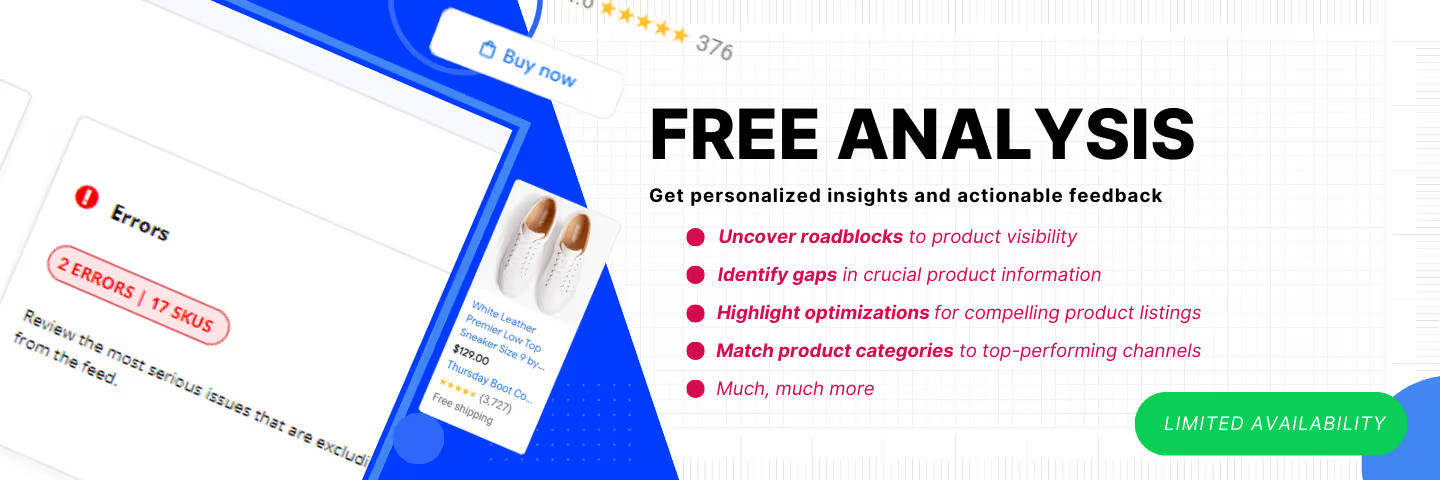Google Merchant Center Next (GMC Next) represents Google's latest effort to enhance the product feed management experience for ecommerce businesses and digital marketers. This updated platform aims to simplify the process of managing and optimizing product listings across Google's vast network, promising greater efficiency and improved user experience. However, as with any significant overhaul, the transition to GMC Next has not been without its challenges. While the new features and streamlined interface are intended to provide substantial benefits, many users have encountered obstacles that impact their ability to leverage the platform effectively. This article explores the tension between the promised advancements of GMC Next and the potential difficulties users face, offering a balanced discussion of its features and limitations.
Key Features of Google Merchant Center Next
GMC Next introduces several innovative features designed to streamline and enhance the product feed management experience for merchants. These enhancements aim to provide a more intuitive and efficient interface, leveraging advanced technology to simplify complex tasks. Here are the main features of GMC Next:
1. AI-Powered Product Image Editing
One of the standout features of GMC Next is its AI-powered product image editing capabilities. This tool automatically enhances product images, ensuring they meet Google's stringent advertising standards. By improving image quality and consistency, merchants can expect better engagement and higher click-through rates. However, the reliance on AI might occasionally result in edits that do not align with a brand's unique aesthetic, necessitating manual adjustments.
2. Automatic Product Addition
GMC Next simplifies the process of adding new products to a merchant's feed. The platform can automatically detect and incorporate new items from a merchant's website, reducing the time and effort required to maintain an up-to-date product catalog. While this automation can be a significant time-saver, it may also lead to the inclusion of products that are not ready for promotion or require further optimization, presenting a potential oversight risk.
3. Enhanced Issue Resolution
To help merchants quickly identify and resolve problems with their product feeds, GMC Next includes enhanced issue-resolution features. The platform provides more detailed notifications and actionable recommendations to address feed errors and policy violations. Although this feature aims to make troubleshooting more straightforward, the increased volume of notifications might overwhelm some users, particularly those managing extensive catalogs.
4. Performance Insights
GMC Next offers improved performance insights, giving merchants access to more granular data about their product listings' performance. These insights can help merchants make data-driven decisions to optimize their feeds and advertising strategies. However, the complexity of interpreting detailed performance metrics may require a higher level of expertise, which could be challenging for smaller businesses or those with limited resources.
While these features of GMC Next are designed to provide substantial benefits to merchants, they also introduce new complexities and potential limitations. Understanding these nuances is crucial for businesses looking to maximize the platform's capabilities while mitigating any unforeseen challenges.

The Transition to Google Merchant Center Next
Google is actively encouraging merchants to upgrade to GMC Next, positioning it as a necessary step to remain competitive in the ever-evolving ecommerce landscape. The push towards this new platform underscores Google's commitment to innovation and improved user experience, yet it also comes with significant implications for businesses currently using the old version of the Merchant Center.
Current Availability and Transition Period: The original version of Google Merchant Center remains available for now, allowing businesses some breathing room to familiarize themselves with GMC Next. However, this coexistence is temporary. Google has not specified an exact end date for the old version, but the gradual phase-out implies that merchants will eventually need to transition fully to GMC Next.
Implications of the Transition: This transition period presents a double-edged sword for businesses. On one hand, it offers an opportunity to adapt to the new system at their own pace, avoiding the pitfalls of a rushed upgrade. On the other hand, the impending obsolescence of the old Merchant Center creates a sense of urgency. Businesses may feel pressured to quickly master the new platform to avoid disruptions in their advertising operations.
Pressure to Adapt Quickly: The pressure to adapt swiftly is particularly pronounced for larger enterprises with extensive product catalogs and complex feed management processes. The learning curve associated with GMC Next, combined with the need to ensure continuous optimization and compliance, can be daunting. Smaller businesses or those with limited technical resources may find the transition even more challenging, as they struggle to keep up with the pace of change while managing day-to-day operations.
As Google continues to refine GMC Next and phase out the old version, ecommerce businesses must stay proactive. Embracing the new platform early, investing in training, and possibly seeking advanced feed management solutions can help mitigate the pressure and ensure a smoother transition.
Main Issues Advertisers Are Facing with GMC Next

Despite Google Merchant Center Next's (GMC Next) promise of streamlined operations and enhanced features, many advertisers have encountered significant challenges that impact their ecommerce operations and marketing effectiveness. Key issues include the lack of feed rules and supplemental feeds, as well as problems with product import.
1. Lack of Feed Rules and Supplemental Feeds
One of the most pressing concerns is the absence of feed rules and supplemental feeds, tools that were essential for many advertisers in the previous version. These tools allowed users to create complex rules for manipulating data within their product feeds, ensuring that the information submitted to Google was accurate and optimized for performance.
Without these features, advertisers are struggling to maintain the same level of control over their product data. For instance, feed rules previously enabled automatic adjustments to product titles, descriptions, and other attributes, based on specific criteria. This automation saved time and ensured consistency across large inventories. The removal of these capabilities means advertisers now face the daunting task of manually updating their feeds, which is both time-consuming and prone to errors.
2. Product Import Problems
Another significant issue is related to product import processes. Many users have reported difficulties with GMC Next correctly importing and updating their product data. Specific examples from the original article highlight how these problems have disrupted operations.
For example, one seller noted, "We’ve had multiple instances where products that were perfectly fine in the old Merchant Center suddenly started showing errors in GMC Next." These errors often require substantial manual intervention to correct, which can delay product listings and reduce the overall efficiency of marketing campaigns.
Another seller mentioned, "The import process is unreliable. Sometimes products are missing, and we have to recheck everything manually." Such inconsistencies not only consume valuable resources but also risk causing inventory discrepancies, leading to potential lost sales and dissatisfied customers.
[Look how to overcome product feed import issues with our Product Feed Data Merge Capabilities]
3. Throttling Product Feeds
Throttling is another issue that continues to plague Merchant Center.
The "throttling" issue in Google Merchant Center refers to the limitation imposed by Google on how often and how many products can be updated or fetched from your feed within a certain time frame.
This restriction can slow down the processing of product data, particularly for large catalogs with frequent updates, resulting in delays in listing updates, potential mismatches in product availability, and inaccuracies in pricing or other critical product details. Throttling is a challenge for ecommerce businesses that need to maintain real-time synchronization across multiple sales channels, and managing it effectively requires strategic feed optimization and timing to ensure that high-priority updates are processed without unnecessary delays.
4. Lack of Direction
This isn’t a new problem to GMC Next, but it’s worth mentioning as the new iteration of Merchant Center doesn’t address it.

Premium data feed management platforms like GoDataFeed not only anticipate errors but also provide actionable insights for resolution. In some cases, the platform’s internal features can be activated to circumvent errors and warnings. In others, explicit guidance is provided so as to solve the issue using logic-based rules or automated overrides based on SKU criteria.
Free platforms like GMC Next don’t provide that level of support. GoDataFeed on the other hand, runs the gamut from totally self-drive DIY software to fully managed white glove services to meet the changing needs of growing businesses.

Impact on Marketing Operations
These issues collectively undermine the efficiency and effectiveness of ecommerce operations. The lack of automated feed rules and supplemental feeds means that businesses must invest additional time and labor into maintaining their product data, diverting resources away from strategic activities like campaign optimization and customer engagement.
Furthermore, problems with product imports can lead to delays in getting new products to market, impacting sales and revenue. Inaccurate or incomplete product data can also result in poorer ad performance, as incorrect listings fail to meet the standards required for optimal placement in Google Shopping ads.
In summary, while GMC Next aims to improve the user experience, the current limitations and issues are causing significant disruptions for advertisers. These challenges highlight the critical need for adaptable, comprehensive feed management solutions that can bridge the gaps left by GMC Next, ensuring seamless and effective ecommerce operations.
Overcoming GMC Next Limitations with Advanced Feed Management Solutions

Advanced feed management solutions are designed to overcome the challenges posed by GMC Next, ensuring that ecommerce businesses maintain efficiency and effectiveness in their product feed management.
Here’s how these sophisticated tools address the limitations of GMC Next:
1. Robust Feed Rules
One of the critical features of advanced feed management solutions is the ability to create and implement robust feed rules. These tools allow businesses to automate complex data manipulations, such as modifying product titles, descriptions, and other attributes based on specific criteria. This automation ensures consistency and accuracy across large inventories, reducing the manual effort required and minimizing the risk of errors.
By maintaining control over product data, businesses can ensure that their listings are always optimized for performance.
2. Comprehensive Product Import Capabilities
Advanced solutions offer reliable and comprehensive product import capabilities, addressing the inconsistencies experienced with GMC Next. These tools can seamlessly import and update product data from various sources, ensuring that all listings are accurate and up-to-date. With features like error detection and automatic correction, these solutions mitigate the risk of missing or incorrect product information, which can disrupt marketing campaigns and sales.
3. Flexible Processing Options
To adapt to the unique needs of each business, advanced feed management solutions provide flexible processing options. This flexibility includes the ability to handle different data formats, customize processing workflows, and integrate with various ecommerce platforms and marketplaces.
Businesses can tailor their feed management processes to suit their specific requirements, ensuring that product data is always aligned with their marketing strategies and goals.
4. Multi-Channel Optimization
Advanced feed management solutions excel in optimizing product listings across various platforms, not just Google’s surfaces.
These tools ensure that product data meets the specific requirements of each channel, whether it's Google Shopping, Amazon, Facebook, or other marketplaces. By optimizing listings for multiple channels, businesses can maximize their reach and performance, driving more traffic and sales.
Ensuring Business Continuity and Adaptability

While platforms like GMC Next offer a powerful portal into digital selling, merchants should be aware of the inherent limitations.
Their free tools often lack the crucial functionality and advanced features needed to optimize product feeds and manage complex data requirements at a high level. Relying solely on these basic solutions can ultimately cost businesses valuable time and effort, as they struggle to adapt to evolving channel demands and rectify errors manually.
In contrast, advanced feed management solutions provide a more reliable and efficient option. These solutions are designed with the user in mind, offering robust, scalable capabilities that are continuously updated to meet the latest industry standards and requirements.
Consider the long-term value and efficiency of your feed management tools to ensure your business is well-equipped to navigate the complexities of ecommerce with confidence.
Advanced feed management solutions like GoDataFeed offer the robust capabilities needed to grow past the limitations of GMC Next.



.webp)

.png)
%20).png)